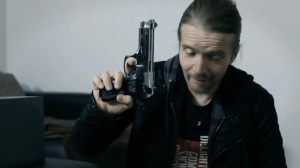Gangsters, guns, violence, wit. Let me begin by praising Tall Tales: Now You Are, Now You’re Gone (Suplje Price: Zdej te je, a zdej te ni) for being thoroughly un-Slovene. It has action and pace, two rare attributes in the world of Slovene cinema, which too often mistakes boring for artsy. It would almost be cheating for a reviewer to say that this is a Slovenian attempt at doing Tarantino, but it must be said, for any viewer will clearly see the film’s inspiration. A rat-a-tat-tat of inter-looped stories about part-gruesome, part-comic/cartoonish gangsters with vivid nicknames, non-chilling violence, and a you-must-do-this-or-else plot is quintessential Tarantino. Even the set pieces tip their hat to a man who, despite his youth (Reservoir Dogs came out as recently as 1992), has already become an “-ism,” or at least an “-esque.” This film is Tarantino-esque, and does admirably well with what it is safe to assume was a modest budget (the IMDb page for this film lists a 100,00 EUR budget).
 Tall Tales opens with a sociopathic gangster named Revolver Ramo demonstrating his suicidal/homicidal penchant for killing people by forcing them to play Russian roulette, with him as an equal partner in the game (he must be a very lucky fellow to have somehow survived years of this behavior). We soon learn that the plot is driven by a two-year-old, entrusted to a pair of potheads for babysitting, who gets out of their apartment (or is kidnapped). The two-year-old must be found, or else Cokre, the boss of an organized crime group with tentacles throughout the Balkans and father of the kid in question, will not be happy and the potheads, along with their immediate superiors in the local branch of the gang, will be killed. The search is on for the missing kid, and they have only two days before the boss shows up. To this plot cocktail, a mixer is added: with a nice injection of surprise, we learn that one of the local gang members is an undercover cop. And the cop unwittingly involves a psychiatrist, to whom he has been confessing a bit too much. So the plot tumbles, and stumbles forward, stirring cartoonish violence and gangsters with a dash of comedy and a jigger of style. I say a jigger of style because, if we’re getting nit-picky, this film feels like it is trying very hard to be stylish. And it works out pretty well (nice sets, in particular). But it has an overall feel of a well-meaning group trying to do a Balkan Tarantino. And, likewise, they do a pretty good job of it. They are also not shy about their inspiration: in one scene, someone shoots a crossbow bolt through a book on Tarantino. There is also a Breaking Bad subplot, complete with an old, meek-looking chemist cooking blue crystal meth in his underwear, aided by a nervous young assistant. I’m inclined to think of this as layered homage with a touch of parody, although some viewers might feel that it is a bit too derivative.
Tall Tales opens with a sociopathic gangster named Revolver Ramo demonstrating his suicidal/homicidal penchant for killing people by forcing them to play Russian roulette, with him as an equal partner in the game (he must be a very lucky fellow to have somehow survived years of this behavior). We soon learn that the plot is driven by a two-year-old, entrusted to a pair of potheads for babysitting, who gets out of their apartment (or is kidnapped). The two-year-old must be found, or else Cokre, the boss of an organized crime group with tentacles throughout the Balkans and father of the kid in question, will not be happy and the potheads, along with their immediate superiors in the local branch of the gang, will be killed. The search is on for the missing kid, and they have only two days before the boss shows up. To this plot cocktail, a mixer is added: with a nice injection of surprise, we learn that one of the local gang members is an undercover cop. And the cop unwittingly involves a psychiatrist, to whom he has been confessing a bit too much. So the plot tumbles, and stumbles forward, stirring cartoonish violence and gangsters with a dash of comedy and a jigger of style. I say a jigger of style because, if we’re getting nit-picky, this film feels like it is trying very hard to be stylish. And it works out pretty well (nice sets, in particular). But it has an overall feel of a well-meaning group trying to do a Balkan Tarantino. And, likewise, they do a pretty good job of it. They are also not shy about their inspiration: in one scene, someone shoots a crossbow bolt through a book on Tarantino. There is also a Breaking Bad subplot, complete with an old, meek-looking chemist cooking blue crystal meth in his underwear, aided by a nervous young assistant. I’m inclined to think of this as layered homage with a touch of parody, although some viewers might feel that it is a bit too derivative.
 A film like this should be judged relative to its national peers, rather than up against international competition with ten, or even one-hundred times the budget. Within that context, this is a fine, fun film. It has refreshing wit: a gangster wants to entertain the two-year-old and says, “Want to see something? My mother gave it to me,” then pulls out a gun. The complaints that keep this from being top-drawer are minor: a very un-psychiatrist-like psychiatrist, most characters are one-dimensional caricatures, borrowed ideas and set-pieces. But it is at the highest level of contemporary Slovene cinema and, thankfully, caters to popular, not art-house, tastes – a rarity in that part of the world. Its nearest kin would be Here and There (Tu pa Tam), the 2004 debut of now-famous director Mitja Okorn (whom I profiled in Film International, vol. 12, no 1/2014). That was shot on a non-existent budget (they didn’t even have cash to make the film projector-ready, and it was supposedly partially-financed, without interest, by gangsters) but has a similar level of cartoon-gangstery fun. One wonders what the teenage Okorn would have done with this film’s far more generous budget.
A film like this should be judged relative to its national peers, rather than up against international competition with ten, or even one-hundred times the budget. Within that context, this is a fine, fun film. It has refreshing wit: a gangster wants to entertain the two-year-old and says, “Want to see something? My mother gave it to me,” then pulls out a gun. The complaints that keep this from being top-drawer are minor: a very un-psychiatrist-like psychiatrist, most characters are one-dimensional caricatures, borrowed ideas and set-pieces. But it is at the highest level of contemporary Slovene cinema and, thankfully, caters to popular, not art-house, tastes – a rarity in that part of the world. Its nearest kin would be Here and There (Tu pa Tam), the 2004 debut of now-famous director Mitja Okorn (whom I profiled in Film International, vol. 12, no 1/2014). That was shot on a non-existent budget (they didn’t even have cash to make the film projector-ready, and it was supposedly partially-financed, without interest, by gangsters) but has a similar level of cartoon-gangstery fun. One wonders what the teenage Okorn would have done with this film’s far more generous budget.
 The pace of Tall Tales impressed me most. Having seen a lot of Slovene films, I am used to slow, deep, thoughtful, artsy; and there’s a mood and a time when this can be enjoyed. I love Tarkovsky, for instance. But there is a very fine line between doing slow and artsy well, and putting your audience to sleep, or forcing critics to assume that they must have missed something and, therefore, reading more into the slow depths than there actually is. There is no such danger with this whizz-bang film, which, thankfully, celebrates fun over artistry. This is the sort of film that people can enjoy watching and which could actually make money if it found distributors abroad (most Slovene films never bother trying, and no Slovene film has ever made money, as in broken into the black). Above all, it is a strong start for the promising career of writer/director/co-star Samir Bajic, who shows an impressive knowledge of his genre, a deft hand, and – thank goodness – the pace all too often lacking from small-scale central and Eastern European cinema.
The pace of Tall Tales impressed me most. Having seen a lot of Slovene films, I am used to slow, deep, thoughtful, artsy; and there’s a mood and a time when this can be enjoyed. I love Tarkovsky, for instance. But there is a very fine line between doing slow and artsy well, and putting your audience to sleep, or forcing critics to assume that they must have missed something and, therefore, reading more into the slow depths than there actually is. There is no such danger with this whizz-bang film, which, thankfully, celebrates fun over artistry. This is the sort of film that people can enjoy watching and which could actually make money if it found distributors abroad (most Slovene films never bother trying, and no Slovene film has ever made money, as in broken into the black). Above all, it is a strong start for the promising career of writer/director/co-star Samir Bajic, who shows an impressive knowledge of his genre, a deft hand, and – thank goodness – the pace all too often lacking from small-scale central and Eastern European cinema.
Noah Charney is a professor of art history and best-selling author. He teaches courses on writing at University of Ljubljana and for the Guardian Masterclasses. For more information visit www.noahcharney.com or join him on Facebook.

